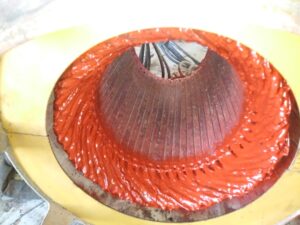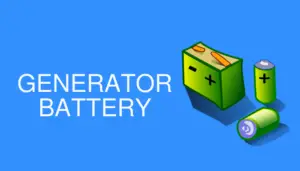An electric generator is a device that converts mechanical energy into electrical energy. It typically consists of a coil of wire (the rotor) that is rotated within a magnetic field, inducing an electric current in the wire.
This process is used to generate electricity in power plants, portable generators, and various other applications.
Table of Contents
Working Principle of AC Generator
The working principle of an AC generator is based on Faraday’s Law of Electromagnetic Induction, which states that a voltage (electromotive force, or EMF) is induced in a conductor when it experiences a changing magnetic field.
Key Components of an AC Generator:
- Stator: The stationary part of the generator where the output current is generated. It typically consists of a set of coils wound on an iron core.
- Rotor: The rotating part of the generator that produces the changing magnetic field. It can be a magnet or a set of coils supplied with DC to create a magnetic field.
- Slip Rings and Brushes: These allow electrical contact between the rotating rotor and the external circuit while enabling free rotation.
Working Principle:
-
Magnetic Flux and Rotation:
- When the rotor rotates, it causes the magnetic field to move relative to the stator coils.
- The rotation is usually achieved by a prime mover, such as a steam turbine, water turbine, or engine.
-
Induction of EMF:
- As the magnetic field changes through the stator coils due to rotor movement, a time-varying magnetic flux is produced.
- According to Faraday’s Law, this changing flux induces an EMF in the stator windings.
-
Generation of Alternating Current (AC):
- The induced EMF is sinusoidal because the magnetic field changes direction periodically as the rotor spins.
- The frequency of the AC depends on the speed of rotation and the number of poles of the rotor.
-
Output:
- The induced current is collected from the stator windings and supplied to an external circuit.
Simplified Steps:
- A prime mover rotates the rotor.
- The rotor creates a changing magnetic field around the stator.
- The changing magnetic field induces a sinusoidal voltage in the stator windings.
- The voltage generates an alternating current in the external circuit.
Applications:
AC generators are used in power plants, industries, and small-scale energy generation systems to produce electricity for residential and commercial use.
Would you like a diagram or any additional details?
types of AC generators
AC generators are categorized based on their design, application, and method of excitation. Below are the main types of AC generators:
Based on Rotor Design
A. Synchronous Generators
- Description: Operate at a constant speed in sync with the power system frequency.
- Applications:
- Power plants for electricity generation.
- Grid-connected systems.
B. Asynchronous Generators (Induction Generators)
- Description: Operate slightly out of sync with the system frequency. They require an external supply to initiate operation.
- Applications:
- Small-scale wind turbines.
- Backup generators in industries.
Based on Method of Excitation
A. Self-Excited Generators
- Description: Use residual magnetism in the rotor to generate the required magnetic field. Once started, they sustain their excitation.
- Applications:
- Portable generators.
- Emergency power systems.
B. Separately Excited Generators
- Description: Use an external DC source (e.g., a battery or another generator) to provide the magnetic field.
- Applications:
- Industrial applications where precise voltage control is needed.
- High-capacity generators.
Based on the Number of Phases
A. Single-Phase Generators
- Description: Produce a single alternating voltage wave.
- Applications:
- Low-power applications, such as household appliances.
- Portable generators for small-scale use.
B. Three-Phase Generators
- Description: Produce three alternating voltage waves, 120° apart in phase.
- Applications:
- Industrial and commercial power supply.
- Large-scale power generation.
Based on Prime Mover Type
A. Steam-Turbine Generators
- Description: Driven by steam turbines, commonly used in thermal and nuclear power plants.
- Applications:
- High-capacity power generation for grids.
B. Gas-Turbine Generators
- Description: Driven by gas turbines, used for quick-start applications.
- Applications:
- Peaking power plants.
- Emergency power supply.
C. Water-Turbine Generators
- Description: Driven by water turbines in hydroelectric power plants.
- Applications:
- Renewable energy systems.
D. Wind-Turbine Generators
- Description: Driven by wind turbines to convert wind energy into electricity.
- Applications:
- Wind farms and renewable energy solutions.
Based on Cooling Methods
A. Air-Cooled Generators
- Description: Use air to cool the generator components.
- Applications:
- Small to medium-sized generators.
Read also my article What is Synchronous Generator?
B. Hydrogen-Cooled Generators
- Description: Use hydrogen gas for cooling, as it has higher heat conductivity.
- Applications:
- Large power stations.
C. Water-Cooled Generators
- Description: Use water as a cooling medium for high-efficiency cooling.
- Applications:
- Very large industrial or utility-scale generators.
Based on Output Voltage
A. Low-Voltage Generators
- Description: Generate output voltages below 1 kV.
- Applications:
- Portable and residential use.
B. High-Voltage Generators
- Description: Generate output voltages above 1 kV.
- Applications:
- Power plants and transmission systems.
For more information read my detailed article about electric generator synchronization
Is the AC generator rated in kVA or kW?
AC generators (alternating current), whether synchronous or asynchronous, are rated in two key units: kW (kilowatts) and kVA (kilovolt-amperes). These ratings indicate the generator’s power capacity and performance.
-
kW (Kilowatts):
This measures the real power the generator can deliver to run electrical devices like lights, motors, and heaters. It’s the actual usable power that does the work. -
kVA (Kilovolt-Amperes):
This measures the apparent power, which includes both real power (kW) and reactive power (needed for devices like motors to work properly and maintain voltage). Reactive power doesn’t do useful work but is crucial for stable operation.
In short, kW is the power you can use, while kVA shows the total power the generator can handle, including support for equipment with inductive loads.
Generators are rated in kVA to account for both real and reactive power. The relationship between real power (kW), apparent power (kVA), and power factor (PF) is as follows:
kW = kVA × PF
Where:
– kW is the real power output in kilowatts.
– kVA is the apparent power output in kilovolt-amperes.
– PF is the power factor, which is the ratio of real power (kW) to apparent power (kVA). It is a value between 0 and 1, indicating how effectively the generator converts apparent power into real power.
In simple terms:
- The kW rating shows the generator’s actual usable power for running devices like lights, motors, or appliances.
- The kVA rating indicates the total power capacity, including its ability to handle reactive loads like motors.
Both ratings are essential for choosing the right generator to meet your power needs and ensuring it works efficiently in your electrical system.
Different Parts of AC Generator
An AC generator, or alternator, has several key components that work together to transform mechanical energy into electrical energy. Here’s a simplified overview of its main parts:
1. Rotor
- The rotating part of the generator, often mounted on a shaft and connected to a mechanical energy source (e.g., turbine, engine, or windmill).
- Contains coils or windings that rotate within a magnetic field to produce electricity.
2. Stator
- The stationary part that surrounds the rotor.
- Holds the coils or windings where the generated voltage is induced by the interaction with the rotor’s magnetic field.
3. Excitation System
- Provides the magnetic field needed for operation.
- May use permanent magnets, DC-powered field windings, or a separate exciter generator.
4. Slip Rings and Brushes (if applicable)
- Found in some generators to transfer electricity from the rotating rotor to external circuits.
- Slip rings: Mounted on the rotor shaft for electrical contact.
- Brushes: Stationary parts that touch the slip rings to collect current.
5. Terminal Box
- The point where the generated electricity is transferred to external circuits or loads through output terminals.
6. Bearings and Lubrication
- Bearings support the rotor shaft and ensure smooth rotation.
- Lubrication minimizes friction and wear.
7. Cooling System
- Dissipates heat produced during operation.
- Includes fans, radiators, or other cooling methods based on generator size and usage.
8. Voltage Regulator and Control System
- Regulates the generator’s output voltage.
- Manages frequency and power factor for stable operation.
9. Frame and Housing
- Provides structural support and protects internal parts from damage or environmental factors.
- Helps reduce noise.
10. Protective Devices
- Safeguards the generator and connected systems from faults or overloads.
- Includes circuit breakers, fuses, and overcurrent relays.
11. Governor (if engine-driven)
- Controls the speed of the driving engine to maintain consistent generator frequency.
This setup ensures reliable electricity generation for a variety of applications, from home use to large industrial operations. Let me know if you’d like more details or a diagram!

AC generator protection
AC Generator Protection is vital for ensuring the safe and efficient operation of alternators in power plants, industrial facilities, and backup systems. Protection systems monitor the generator’s performance and prevent damage by responding to faults or abnormal conditions. Here’s a simplified breakdown of common protections:
1. Overcurrent Protection
- Prevents damage from excessive current flow.
- Uses devices like circuit breakers and fuses that trip when current exceeds safe levels.
2. Overload Protection
- Protects against sustained high loads that can overheat the generator.
- Trips the system if the load stays above the generator’s capacity for too long.
3. Short Circuit Protection
- Detects and isolates the generator during short circuits using high-speed circuit breakers.
- Prevents damage to the generator and connected equipment.
4. Earth Fault Protection
- Identifies faults to ground and isolates the system to avoid hazards like electric shocks or equipment damage.
5. Overvoltage and Undervoltage Protection
- Monitors voltage levels to ensure they stay within safe limits.
- Trips the generator or adjusts voltage if levels are too high or too low.
6. Overfrequency and Underfrequency Protection
- Detects frequency deviations caused by speed changes or load loss.
- Activates corrective actions or trips the generator if necessary.
7. Differential Protection
- Compares input and output currents to detect internal faults, like winding issues.
- Essential for large generators.
8. Loss of Excitation Protection
- Detects loss of the magnetic field required for operation.
- Prevents generator instability or voltage collapse.
9. Reverse Power Protection
- Stops the generator from consuming power (acting as a motor) during reverse power flow.
10. Overtemperature Protection
- Uses sensors to monitor and control generator temperature.
- Trips the generator if overheating occurs due to high loads or cooling failure.
11. Synchronization Protection
- Ensures the generator matches grid conditions (frequency, voltage, and phase) before connecting.
- Prevents phase mismatches and potential damage.
12. Emergency Shutdown
- Triggers in extreme situations like catastrophic failure, fire, or safety concerns.
- Shuts down the generator to prevent further damage.
13. Generator Grounding
- Ensures safe operation and fault prevention through proper grounding and grounding protection.
By integrating these protections, AC generators ensure reliable operation while preventing failures and enhancing safety for connected systems and personnel.
Protection systems typically use a mix of relays, sensors, alarms, and automated controls to quickly detect and address abnormal conditions.
These measures help:
- Minimize downtime
- Protect equipment
- Ensure safe and efficient operation of both the generator and the electrical system.
The exact protection setup depends on the generator’s type, size, and intended application.
advantages and disadvantages of AC generators
Advantages of AC Generators
-
Efficient Power Transmission
- AC generators produce alternating current, which is easy to transmit over long distances with minimal power loss.
-
Compatibility with Electrical Systems
- Most electrical devices and appliances are designed to operate on AC, making AC generators widely applicable.
-
Ease of Voltage Regulation
- Voltage levels can be adjusted easily using transformers, making them suitable for diverse applications.
-
Lower Maintenance
- AC generators typically have fewer moving parts than DC generators, leading to reduced wear and lower maintenance needs.
-
Wide Range of Applications
- Used in power plants, industrial facilities, and portable generators for homes, making them versatile.
-
Higher Efficiency for Large Loads
- AC generators are more efficient in handling large loads and high power output.
Disadvantages of AC Generators
-
Complex Design
- The system involves components like transformers and rectifiers, increasing complexity compared to DC systems.
-
Reactive Power Issues
- AC generators can produce reactive power, which may require additional equipment (like capacitors) to manage and maintain power quality.
-
Harmonic Distortion
- Nonlinear loads connected to AC generators can cause harmonics, affecting performance and efficiency.
-
Synchronization Challenges
- When connecting to a grid or other generators, synchronization of voltage, frequency, and phase is required, adding complexity.
-
Less Suitable for Low-Voltage Applications
- DC generators are often preferred for small-scale or low-voltage needs, like in electronics and batteries.
-
Higher Initial Cost
- The setup cost for AC generators, including protective systems and controls, can be higher compared to simpler DC systems.
These pros and cons make AC generators ideal for large-scale and versatile applications, while DC generators are better for specific, low-voltage needs.
Is an AC generator called an alternator?
Yes, an AC generator, also known as an alternator, is a device that converts mechanical energy into alternating electrical energy.
Linear Alternators
Linear alternators operate by moving the armature while the magnetic field remains stationary. They are used in various specialized applications.
Key Difference Between Generators and Alternators
- In an alternator:
- The armature is stationary.
- The magnetic field rotates.
- In a generator:
- The armature rotates.
- The magnetic field is stationary.
This difference in design impacts how each device operates and is used in different applications. Alternators are commonly preferred for modern systems due to their efficiency and design simplicity.
Don’t Leave Empty-Handed!
Install my Free Android App on Google Play:
Electrical Cables Most Common Tables “Cables Tables”
And, my Electrical Calculations App “Fast Electrical Calculator”
Discover more great content by subscribing to My channel
Looking to stay ahead of the game in the world of electrical engineering? Subscribe to my YouTube channel and gain access to exclusive content you won’t find anywhere else!
The staff I recommend
(Amazon Affiliate Links to products I believe are high quality):
- Economy 120 Volt/60Hz AC Power Source – Step-Down Voltage & Frequency Converters 1800W
- UNI-T Digital Multimeter Tester UT139C
- 50-Amp Extension Cord for RV “100ft”
- Voltage Stabilizer 110/220v
- Hair Dryer “best selling“
- TOSHIBA EM131A5C-BS Countertop Microwave Ovens
Disclaimer: This contains affiliate links to Amazon products. I may earn a commission for purchases made through these links.


